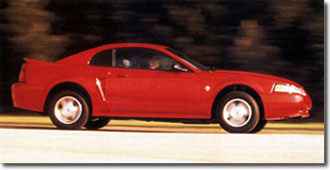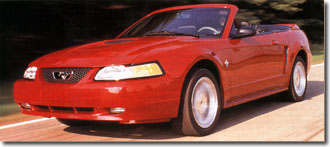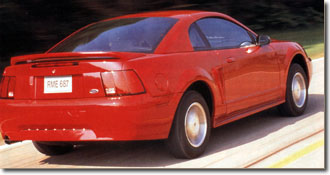
Closer To The Edge

For its 35th birthday, the Mustang gets more power, more poise and a sharp new suit.

Closer To The Edge

For its 35th birthday, the Mustang gets more power, more poise and a sharp new suit.
 Behind the engine, there are plenty of improvements in the drivetrain, too. All models, regardless of engine or transmission, get a 3.27 :1 rear axle ratio (last year, a 2.73 was standard, with 3.08 and 3.27 ratios optional at extra cost). Obviously, all models will be quicker in 0-60 mph acceleration with the new 3.27:1 screw.
Behind the engine, there are plenty of improvements in the drivetrain, too. All models, regardless of engine or transmission, get a 3.27 :1 rear axle ratio (last year, a 2.73 was standard, with 3.08 and 3.27 ratios optional at extra cost). Obviously, all models will be quicker in 0-60 mph acceleration with the new 3.27:1 screw.  Since the 1999 model marks the 35th anniversary of the Mustang, every car, whether it is a V6 or a GT, will carry a front fender tri-bar Mustang badge with a ring around it signifying the anniversary (though there may indeed be a special 35th anniversary car in the Spring to celebrate the April 17, 1964 introduction of the car).
Since the 1999 model marks the 35th anniversary of the Mustang, every car, whether it is a V6 or a GT, will carry a front fender tri-bar Mustang badge with a ring around it signifying the anniversary (though there may indeed be a special 35th anniversary car in the Spring to celebrate the April 17, 1964 introduction of the car).
|
| |||||||||||
Copyright © 1996, 1997, 1998 The Auto Channel.
Send questions, comments, and suggestions to
Editor-in-Chief@theautochannel.com